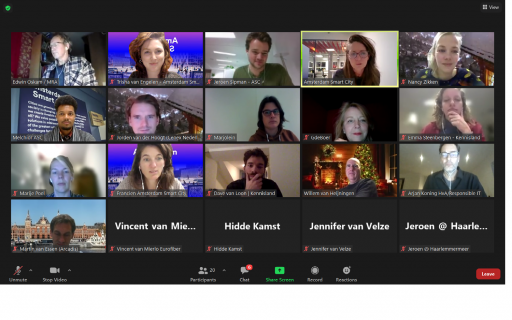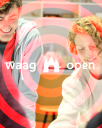On December 14 2021, we had a very special demo day. Of course, it was the last of the year. As the Amsterdam Smart City core team, we are very proud of all the collaborations our partners and community started and that's why we wanted to highlight a few of them. To give the demoday a typical Christmas vibe, the pitchers had a 'gift' for the participants: their lessons learned that everyone could benefit from. And the participants had a gift in return: answers to the questions of the pitchers. In short, a demo day with new projects, questioning and sharing insights!
Responsible Sensing Lab and Drones
Hidde Kamst of the City of Amsterdam tells the participants about the Responsible Sensing Lab, a collaboration between the municipality and AMS Institute. This Lab works on the implementation of (social) values in technology in the city. Cameras and sensors in public space can put values such as privacy and anonymity under pressure. The Responsible Sensing Lab researches and designs alternatives. This also applies to the subject of Responsible Drones. A group of civil servants, companies and knowledge institutions worked on a vision on the responsible use of drones. The subjects 'proportionality', 'communications' and 'rules of the game' were discussed.
Hidde’s lessons learned: behind the scenes there are many parties working on drones, but the involvement of residents and civil society is low. It is important to change this because drones can have a big impact on our society. In addition, it is a complex topic where more research is needed. Hidde's request for help 'How do you convey the urgency of a subject that is important, but not yet urgent?' was very recognizable for the participants. A selection of their ideas: repeat the urgency over and over again, visualize the urgency, use storytelling and name the risks.
Shuttercam and Measuring Public Space
Pitch 2 had a big link with Hidde's story. Tom van Arman does various sensing projects on the Marineterrein, also covered by the Responsible Sensing Lab. An example is the Shuttercam, a camera that citizens can put on or off. In this way they can have an influence on the technology in the city. We start Tom's pitch with a question to the participants. Do they find it important that we measure a lot and collect data to improve the city or would they rather see more privacy for residents? A question that provokes discussion.
Tom has been engaged in measuring and testing in the public space for years, with an important role for public values. That's why he learned a lot of lessons: make sure you take the time to get legislation in order, take vandalism into account, do everything you can to make your work understandable for citizens. And a very nice one to remember: a hot camera attracts many insects. They block the image or get into the devices. One of the best tips he got from the participants: let passers-by write down what they see. That way you can get great feedback.
Braking energy and Pilot OV E-hub
André Simonse from Firan (Alliander) introduced us to the 'braking energy' issue, or as it is now is called: the OV E-hub pilot. This started as a search with partners such as AMS Institute, Arcadis, the City of Amsterdam, the
VRA and Alliander. Now the process evolved into a collaboration between Strukton Rail, Hedgehog Applications and Firan. Big cities can no longer cope with the increasing demand for sustainable energy. This makes it more difficult to access mobility hubs, such as stations, to provide electricity. It is therefore important to use existing energy smartly.
The lessons learned in this pitch were about taking action. Although talking is important for ideation and understanding and trusting each other, the art is to work together on a targeted plan for implementation. André's request for help was on how to organize political support. Willem from the City of Amsterdam wants to be part of the initiative and can help to achieve official support.
Social side of hubs
Willem van Heijningen of the City of Amsterdam took the floor to tell us more about its hub mission. A hub can organize mobility in an effective way. Together with others, he is looking how Q-park Europarking in the center of Amsterdam can be transformed to a hub. Think of shared mobility, charging cars and logistics, while preserving the monumental character of the city. Hearing the word ‘hub’, many people will think of a place to connect different forms of mobility. But it is also about energy. At some point, vehicles, vessels or even drones will come by. Since we want to get rid of fossil fuels, a hub will also become the place where these forms of mobility are charged. The success or failure of hubs is all in the hands of people. It depends on their behavior whether hubs will be useful. Until now, they have got too little attention. T
his is where Willem could use some help: What is needed to bring the social aspect of hubs further? How does the hub prove its effectiveness towards humans? A selection of the answers from the group: investigating the needs of the residents, connect with existing social initiatives in the city, involve local entrepreneurs.
ArenAPoort LIFE
Else Veldman and Hans Roeland Poolman from AMS Institute took us on a tour to their Southeast Energy Lab. This is a collaboration to accelerate sustainability in the southeast of Amsterdam through practical research, meetings and concrete projects. One of the current projects is the LIFE project, an open platform to plan energy supply and demand in a smarter, inclusive way. An enormous ambition that is driven by partners such as Johan Cruijff ArenA, Alliander, Spectral, CoForce and the Utrecht University. AMS Institute is committed to ensuring this platform is not only a technical contribution to the energy transition, but also provides social value to the inhabitants of South-East.
Hans and Else asked the network to think about the latter. The result was a tidal wave of tips to involve residents: co-develop communication strategies such as storytelling and visualization, pay attention to the result, the dream, show what it means to participate in the process, and above all, invest time.
New narrative for the energy transition
The last pitch was about the New Narrative where Kennisland and What Design Can Do on behalf of RES Noord-Holland have been working on. Dave van Loon from Kennisland told us that a new story about the energy transition is being developed to move away from the negative image, people's concerns and to give a new impulse to the energy transition. This narrative is based on a design thinking process. Subsequently, the organizations developed building blocks to focus on:
- a shared sense of urgency
- a positive future perspective
- inspiration by concrete and recognizable examples and success stories
- a sense of pride
- a way to take of action
Dave's request for help was for a reflection on this process. And the reactions were praising. On the one hand, the feedback focused on how to make the story as concrete as possible for the target groups and on the other hand on reaching the masses, while incorporating those who are left behind.
The next demoday will take in place in February or March. Do you have a nice story to tell or would you like to join as audience? You are more than welcome! Drop a line below to let us know!





